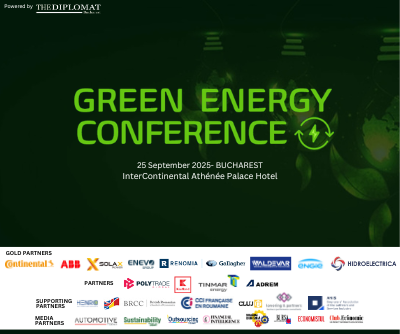EPG: Successful CfD auction brings optimism, but industry challenges persist

Opinion by Energy Policy Group (EPG) experts Nadia Maki and Radu Dudău
Romania adopted Government Decision No. 318/2024 in April 2024, introducing a Contracts for Difference (CfD) scheme to support low-carbon emissions technologies. Throughout the summer of 2024, ANRE set out the methodology for determining and collecting CfD contributions, and the Ministry of Energy approved the state aid scheme.
The first CfD auction has concluded and successfully procured the target c. 1.5 GW of installed capacity (1,096 MW for onshore wind and 432 MW for solar). Following the technical evaluation, 47 bids were eligible for financial evaluation with 21 applicants awarded contracts. Maximum prices were set at €78/MWh for solar and €82/MWh for onshore wind and a weighted average of the strike prices were €51/MWh for solar and €65/MWh for wind, representing good value for money. A second auction with 3.5 GW (1.5 GW for onshore wind and 2.0 GW for solar) is scheduled for the third quarter of 2025. Future auctions may include other technologies, such as offshore wind and nuclear.
A CfD contract will last for 15 years. The Modernisation Fund supports the scheme with €3 billion until 2030, after which the cost of maintaining it is to be passed onto the consumer bills. This guaranteed revenue stream over 15 years enables developers to secure financing by ensuring predictable payback periods and minimum returns on investment, protecting investors from market fluctuations.
CfDs are an important tool meant to shield select power generation technologies from market volatility and to provide long-term stability. Despite this successful first auction, though, the Romanian renewables sector is still proceeding with caution, as some language in the CfD contract is less comforting than it first appeared.
Industry concerns
Concerns over stability have been raised by some stakeholders, notably that the contract as written offers limited projection for power generators that are taking on more risk with the Romanian CfD than in CfD schemes in other states.
Reference price methodology
The draft methodology for setting the reference price has been viewed positively by industry, although the final methodology has yet to be released by the energy regulator. The reference price definition poses a risk to generators as ANRE reserves the right to revisit the methodology at any point if they consider that the reference price is not adequately reflecting market trends. However, how exactly ANRE is to (re)assess the situation is not clear. This is a surprising contractual clause considering that the reference price is based on the average day-ahead power market, which should be a straightforward market reading. EPG suggests that wording around adjusting the reference price methodology should at least be limited to a specific percentage point to allow electricity producers to model for the worst-case scenario when deciding on submitting a bid in future auction rounds.
Consumer Price Index
Concerns have been raised over the absence of cumulative Consumer Price Index (CPI) evolution. In theory, the CfD strike price should be adjusted every three years based on CPI; however, adjustment only applies if CPI increases more than 10%. Therefore, any inflation below 10% will not be adjusted for, leaving generators to deal with losses based on inflation of up to that threshold. Indeed, CPI-based adjustments are in line with the Eurozone Consumer Price Index, which is generally more conservative than the Romanian CPI. The long-term nature of CfDs means that real inflation could outstrip CfD payments and significantly impact returns. The unbalanced burden of managing inflation falling on the generator does not match the de-risking purpose of a CfD.
State unilateral exit
The state has the right to unilaterally terminate a CfD contract at its convenience, which many in industry find unacceptable and undermining the scheme’s very sense: to allow for a longterm, predictable revenue stream.
Under this clause, the generator is entitled to payments which theoretically should amount to what they would have received had the contract lasted to full fruition. As always, though, the devil is in the details and the methodology used for calculating the termination payment is not clear-cut. Based on the formulas outlined in the contract, the termination compensation should equate to the generator’s market loss based on the historical weighted average of CfD difference payments since the start date and metered output from the previous year, including a discount rate. However, the generator risks the state terminating the contract following a stable year before the market takes a turn, leaving the generator to carry the burden alone. If the market remains relatively stable, the termination amount would reasonably closely match what the generator should have received. In this situation, though, why would the government choose to exit the contract?
Besides, the reference price calculations will play a significant role in the level of termination fee paid to generators. If these values are transparent and fair, there is a scenario where the generator is fairly compensated, but a clause which allows one party to unilaterally terminate the contract without cause does not inspire confidence.
Regulatory aspects outside the generator’s control
The responsibility of achieving grid connection (ATR) falls on the electricity producer’s shoulders, with little recourse if decisions from the TSO are outside their control. At the auction stage, bidders must evidence the application for ATR. However, they are responsible for achieving ATR within six months of signing the CfD contract, and some bidders have justifiably expressed concerns over tight timelines, especially as decisions around grid connections are in the control of the TSO, while bidders have little control over the decisionmaking timelines.
The Government Ordinance 59/2013 stipulates that grid connection must be granted by the TSO within six months of application, but in practice it can take over a year. Generators therefore take a risk of not being granted connection agreements on time. The TSO’s ability to accommodate an influx of new grid connection agreements is known to be facing difficulties. If the TSO cannot come to a decision in the 6-month timeline, the CfD Counterpart is within their rights to enforce performance bonds on the bidder. Similarly, the process to obtain a building permit is not guaranteed and the risk of failure or delays may also affect the generator’s ability to see the project to fruition and incur significant penalties.
The importance of getting it right
The introduction in Romania of a CfD scheme and the successful first tender have marked a significant achievement. Still, the success is dependent on the scheme’s ability to leverage private sector investment. The name of the game is stability – not only in price but also in regulatory certainty. Is the CfD going to provide a stable regulatory market ripe for investment?
Previous schemes to incentivise the development of renewable energy in Romania underwent numerous changes which undermined the predictable nature of long-term support. For example, the Green Certificate scheme saw significant adjustments to the quotas, validity periods and trading rules. The energy market in Romania has also seen unexpected regulation, sometimes at seemingly random times, for example as with the windfall tax on renewable energy power plants and the obligations for (most) conventional producers to sell electricity exclusively on a centralised market until earlier this year.
Moreover, the implicit benchmark of success for the recent first CfD tender – i.e., the low strike prices achieved competitively – may risk the projects’ viability, especially if the winners commit to unrealistically low prices and tight time schedules. The worry is compounded by the fact that the offers by much larger, established contenders, such as PPC, Engie and OMV Petrom, have all lost to much smaller and often less known companies, which came out on top with strike prices as low as EUR 45 MWh for solar and EUR 54.5 MWh for wind energy. At the end of the day, the public interest is that the awarded projects come online in the agreed timeframes, with robust operational management.
In any event, the first round of CfD auctions will set the tone for future auctions to come, with the potential to establish Romania’s position as a trustworthy partner for the development of large-scale renewable energy infrastructure. Conversely, perceptions of unreliability may become a tough hurdle to overcome once cemented within industry.















